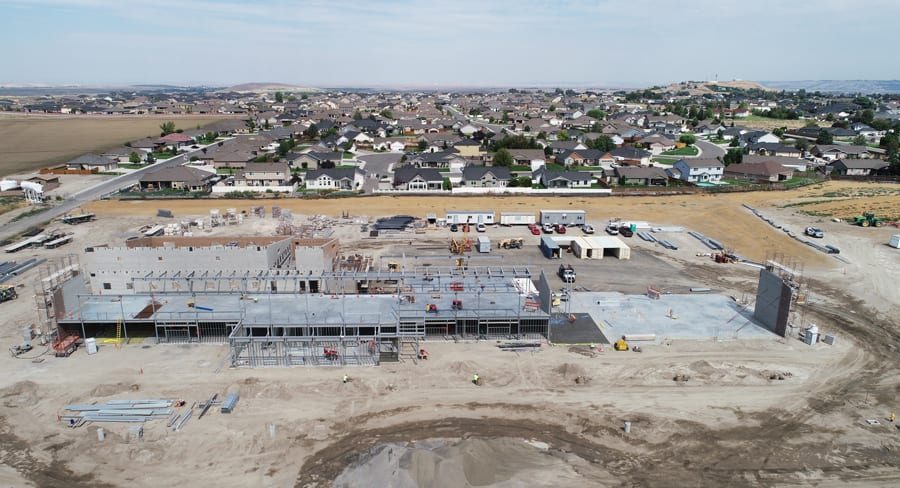
Home » City of West Richland: ‘bedroom community’ expands west
City of West Richland: ‘bedroom community’ expands west

October 30, 2018
At 15,320 citizens strong, West Richland is looking to its undeveloped western end of town as the focus for future growth.
“The center of town is pretty much built out,” said Aaron Lambert, West Richland’s community development director.
What feels like the center of town for West Richland tends to be the area near Yoke’s Fresh Market at 1401 Bombing Range Road. But future development will result in more homes and commercial projects in the western part of town, south of North Harrington Road, north of Ruppert Road and terminating at the Yakima River.
West Richland has infrastructure plans to support future growth.
“Keene Road will extend out to Twin Bridges Road, so you have a direct connection to the jobs in the Hanford area,” Lambert said. “So with our growth that direction, westerly, we put the zoning in place to promote commercial, and also acknowledge residential growth, as well, since it really drives our community. We have a lot of capacity to grow, and our latest comprehensive plan, planned for 2037, we’re expected to accommodate 23,000 people, but we always seem to eclipse the current projections.”
West Richland wants to encourage commercial growth to allow more retail within the city. “A lot of shopping occurs before (residents) come home, so that’s something we’re working on trying to boost,” Lambert said.
It’s long been known as a bedroom community. “Our residents really like the quality of life here,” he said.
Calling single-family homes the city’s “core development,” Lambert said a lot of commercial growth in West Richland is “school-driven.” This includes the construction of a 65,000-square-foot elementary school underway at Belmont Boulevard and Bluewood Street, across Keene Road from the new $35 million Leona Libby Middle School, which opened in fall 2017.
Still unnamed, the school is set to open in 2019 and accommodate up to 600 students.
An overhaul of Tapteal Elementary is also part of a $99 million Richland School District bond passed by voters in 2017. West Richland students are served by the district, which bought 72 acres next to Libby to serve as the site of a future high school.
Libby sits adjacent to the city’s new municipal services building at 3100 Belmont Blvd. It houses West Richland’s municipal services and finance offices, which moved from the city complex on Van Giesen Street, where the city’s police station and library are located. The city of West Richland intends to sell the two vacated buildings.
Lambert said the city is working with a surveyor to parcel out the properties with the goal of getting them on the market this fall.
The Van Giesen core is prepped and ready for development, buoyed by the opening of the $2.2 million Yakima Gateway Riverfront Park project in fall 2017.
A new city entrance sign welcomes visitors to West Richland, as well as added river access, paved trails and a new city park with parking. The improvements were made alongside zoning changes to west Van Giesen Street to allow for development or redevelopment, which had been made stagnant under the previous allowance.
“We made it downtown mixed-use,” Lambert said. “So we acknowledged the existing conditions. There’s a lot of housing, and under the old commercial zoning, they couldn’t rebuild. So if you demolish a home, you’d have to build commercial. And it just wasn’t working. People weren’t repairing their homes or replacing them. So we made downtown mixed use that allows for single-family, multi-family and commercial and then the hybrid, the mixed use.”
The West Richland City Council also approved a 50 percent reduction to the required amount of parking on Van Giesen for commercial use as a way of accommodating the smaller lots that exist in the area.
“They (council) put a lot of zoning in place that allows for flexibility to let the market drive it more than prescriptive zoning,” Lambert said.
The city also is increasing the size of water and sewer lines on Van Giesen. “We’re ready for future development or redevelopment. I think we’ve done all we can to promote it, but you really need the traffic counts to drive that now,” Lambert said.
Interest in the former Tri-City Raceway remains, despite the lack of an immediate plan for development of the site, owned by the Port of Kennewick but annexed by West Richland in 2015.
The raceway is at Keene Road and Highway 224.
“By bringing it into the urban growth boundary and into the city limits, that allows the property to be served by the city, but there’s a great deal of private land in the area. We do not want to compete with the private sector,” said Tana Bader Inglima, deputy chief executive officer for the Port of Kennewick.
“The port expects development to occur on a longer-term schedule,” she said.
That schedule is also dependent on certain “triggers,” like the planned completion of a new Interstate 82 interchange at Red Mountain that’s currently on hold.
The interchange is the second phase of a Washington State Department of Transportation, or WSDOT, project that first began in late 2015 with the addition of a roundabout at the intersection of highways 224 and 225 to increase safety and relieve congestion. WSDOT would like to add a new interchange to improve connectivity to Highway 224 and provide direct access to parts of West Richland currently underserved.
“It would offer a tremendous benefit to the community, and the citizens here, and future economic growth to support the former raceway and Red Mountain Center, at the intersection of Keene and Van Giesen,” Lambert said.
But approval for the interchange has not yet come from the Federal Highway Administration, or FHA, said Alex Sanguino, project engineer for WSDOT. “There’s been issues trying to get them to give the OK,” he said. The holdups are not related to funding, but the FHA decides on the benefits of additional on/off ramps so they don’t defeat the purpose of a highway.
West Richland is also waiting on potential development of a high-profile business, automaker SSC North America, which is headquartered in the city. West Richland used to own the 4.8 acres at 2943 Belmont Blvd., near Keene Road, but it was sold to the commercial arm of developer Ron Asmus for $1.15 million in 2017. The company’s intent is to build a 40,000- square-foot facility on the site, but financing setbacks have slowed plans. The shell building was approved by the city.
“We’re just waiting for the applicant to pick up the permit,” Lambert said.
Named the “best place to raise a family” in Washington state by WalletHub.com in 2017, West Richland is ready and willing to welcome more families to its community, whether on a small or large budget.
“Zoning changes were put in place last fall to support townhouse development. So it’s a great opportunity for a starter home,” Lambert said. “Generally, our market is 12,000-square-foot lots and bigger. That seems to be what developers are platting and what the market will support. So as you start to run out of room, that’s where you find the infill because large lots are not attainable for a first-time homebuyer.”
West Richland issued 42 single-family home permits between January and August 2018, compared to 84 in the same period in 2017.
“We’re trending down on single-family homes, which is our core development. It’s not for lack of physical land area, though,” Lambert said. “We have the land to build, but the tenet of the Growth Management Act is to build up before you sprawl because what it leads to is more efficient use of resources for infrastructure.”
Building up, through the use of multi-family dwellings, has increased the number of these permits issued, from three in 2017 to 12 in 2018.
Commercially, the city issued four permits between January and June 2018, the same amount as the previous year.
“Commercial activity is not great, but that’s kind of reflective of the makeup of the city,” Lambert said.
A number of public works projects are currently underway in West Richland, supporting and improving the current infrastructure.
“We’ve got the whole town torn up,” joked Roscoe Slade, West Richland public works department director. This includes a multi-phase project on Bombing Range Road, a new reservoir at Grosscup Boulevard and Van Giesen, along with work at South 38th Avenue and Mount Adams Drive, as well as portions of Collins Road.
Looking ahead to 2019, Lambert expects the city’s focus to narrow on selling or surplusing properties and acreage around the former municipal services building and its current campus.
“At this point, we’re poised for future growth and development. The development requirements, I think, meet the market right now,” he said.
The market also will drive future infrastructure growth, especially around Red Mountain. “We really expect Belmont and Keene to be a lot more active, and the traffic to keep increasing there,” he said.
Construction + Real Estate
KEYWORDS october 2018





